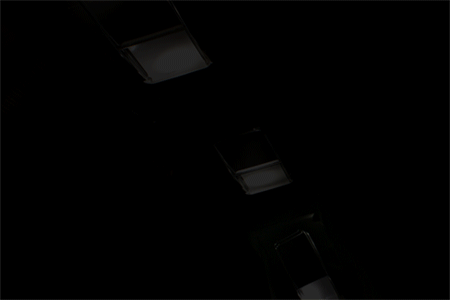
| 2011-2014 Installation -> Spatial animation Back |

Slow Motion, 2011. Physical animation with light. View of the animation construction in the room,
Gävle Konstcentrum, Sweden. Curated by Anna Livion.
In 2011 I made the exhibition Slow Motion at Gävle Konstcentrum, Sweden. The starting point for this project was to go back to the first optical experiments with moving images that Eadweard Muybridge and others was working on at the end of the 19th century and turn the relationship to space and movement inside out. |

Since this project is a bit tricky to document with its flashing lights in a dark space and also, since a filmed documentation brings it back to moving image I have chosen to make the documentation as animated gifs based on photographed documentation. |
In the exhibition Slow Motion, 32 white foldable chairs were animated in a row to generate an image of a chair moving in the room like a Rollercoaster or an assembly line where the first part of the sequence was animated with the chairs upright, like a ride, and the second part with the chairs folded flat. One small loud-speaker was added to each box/frame connected to the electric lamp-cable that would give a small clicking sound when each box/frame was lit up. The speakers where found and collected from a car junkyard and were sorted by size in groups of four to generate a four stroke. This worked as an ambient dolby surround sound soundtrack and also helped the eye to recognize and follow the movement in the dark space and made it possible to increase the speed of the animation. The exhibition was an experiment that turned out to work quite ok and I wanted to try out further possibilities with these spatial animations. |
Slow Motion Scene II, 2014. View of the animation construction in the room, |
| In spring 2014 I made the second scene in Slow Motion in an office space at Stockholm Contemporary at company Britton Britton where I duplicated all objects in the room, a chair, table etc. and placed them side by side in a looped sequence in order to generate the impression of a shaking room, like an earthquake. During this test I realized the significance of the after-image on the retina. The after-image fades away quite slowly and by adding darkness between the light-flashes, the animation could be speeded up without blurring. |
 |
One new option here when working with only two frames in a loop was the possibility to animate a sequence not only in space but also in time, since the narration goes back and forth. |